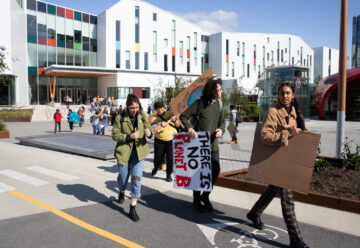ECU Student on Frontlines of Fairy Creek Protests says Blockades are a Battleground for a Sustainable Future

Posted on | Updated
The fight to save Vancouver Island’s ancient trees reveals an existential conflict that must be resolved to foster hope for a better future, says the Two Spirit artist.
Participating in protests against logging old-growth trees on Vancouver Island is about more than protecting forests, Naas tells me. For Naas (a camp alias being used by request), standing with protesters at Fairy Creek is about defending a vision of a sustainable, equitable future, where social and political norms prioritize people and place, instead of profit.
“Ultimately the way to achieve that future is recognizing and respecting Indigenous law and land sovereignty,” Naas says, “The First Nations are the original caretakers of this land and if there is to be hope of recovery, we must allow Indigenous land stewardship to resume.”
Naas, a Two Spirit artist and ECU student currently between his first and second year, is from the Hesquiaht First Nation. As of May, he has been serving as a camp cook on the frontlines of a fight to preserve one of the last stands of ancient trees in British Columbia.
For nearly nine months, protesters at what is broadly known as the Fairy Creek Blockade have been blocking logging company Teal-Jones from accessing a number of stands of old-growth forest in a remote region of southwestern Vancouver Island. Occupying strategic locations in camps along logging roads and on bridges near Port Renfrew, the groups have prevented fallers from accessing the Caycuse watershed to harvest the trees, many of which are hundreds or even thousands of years old — trees that protesters say represent less than three percent of remaining old growth in the province.
And by some accounts, the pressure may be working. On June 9, the BC government announced it is deferring the harvesting of old-growth trees in Fairy Creek and the Central Walbran Valley for two years. The move came following a request from the Huu-ay-aht, Ditidaht and Pacheedaht First Nations to defer old-growth logging while they prepare stewardship plans. But the deferral represents only a start to the work Naas hopes the blockade might accomplish.
“These protests really represent a huge push for recognizing toxic systems, and recognizing we need change, even if it seems impossible at this point in time,” he says. “Because if we don’t change — if we don’t confront extractive resource practices and this idea of working-to-live — there’s not going to be anything left.”
Recent announcements aside, the movement that protesters have declared a “last stand for ancient temperate rainforests” has also met its share of setbacks. Camp occupants were served with a BC Supreme Court injunction on April 1, ordering the blockades be removed. In early May, after campers refused to observe the injunction, RCMP began making arrests, taking control of some of the camps to clear the way for loggers. Since then, more than 190 people have been arrested. And although protesters have support from Pacheedaht Elder Bill Jones, they also faced criticism early on for not receiving official sanction from Pacheedaht First Nation, whose territory includes the Fairy Creek watershed.
(A statement from the Pacheedaht First Nation, released a week after the April injunction was issued, called for an end to the Fairy Creek blockades. The statement, which was co-signed by Pacheedaht Hereditary Chief Frank Queesto Jones and Pacheedaht Chief Councillor Jeff Jones, also indicated the nation is working on a plan to identify areas for conservation.)
Having first joined the Fairy Creek camps earlier in the spring, Naas says the conflict between protesters and industry more recently began to play out at the individual level. Frustrations among loggers, in particular, reached a boiling point when a group appeared at one of the protest camps in May. At that time, Kati George Jim, niece of Bill Jones, told APTN News that the group targeted “only visible minority and Indigenous people at the camp.” Video from the incident documents racist speech from the loggers, ending in what appears to be a physical confrontation with one of the young Indigenous protesters. Kati George Jim said the incident is one of several to have unfolded recently between protesters and fallers; RCMP said at the time they’d begun an investigation after seeing the video.
This interpersonal conflict is no surprise to Naas. Confrontations
are certainly a product of hatred and ignorance, he tells me. They are
an “extension of centuries of violence toward Indigenous people.” But this violence is really a symptom of a broader conflict, he says. And such conflicts emerge by design.
This is how the colonial system works, he says. It pits working people against one another in defence of ways of life that are framed as mutually exclusive. But it’s false to imagine that one has to choose sides in a war between defence of ancient rainforests and making a living for one’s family, he says.
That’s why Fairy Creek is so important, he adds. Defending ancient forests is crucial to the future. But Fairy Creek is a site that reveals an existential conflict that Naas feels must be resolved in order to foster hope for a better future.
“We want to draw attention to the broken, colonial and capitalist systems that we’re all living in, that we’re all taught are normal,” he says. “Through that complacency, we’re just perpetuating these systems that are ultimately going to leave all of us with nothing left.”
The government should act to protect its ancient forests, and create well-paying jobs for resource workers instead of subsidizing extraction, he says.
“The way I see it, these trees are our family from a cultural standpoint. They are our ancestors and our places of worship and ultimately the arms that are going to carry us into the future. And we just keep cutting them down.”
Meanwhile, with the future of Fairy Creek still uncertain, Naas says he hopes to see more public support for the cause. During his last visit to Vancouver, in May, he was gifted a material practice kit — a care package of items donated by the Aboriginal Gathering Place at Emily Carr — as a means to encourage creative practice among Indigenous supporters. Naas says he is particularly eager to see more Indigenous support at the camps, though “numbers and support” of any kind are needed.
Public support has indeed begun to swell. Amid arrests and other RCMP action to quell protests throughout May, recent weeks saw several instances of peaceful groups face potential prosecution to push past police lines and reoccupy areas previously cleared by RCMP. Protesters have also marched outside Teal-Jones headquarters, in Surrey, BC, while solidarity protests have been planned or taken place in numerous cities and towns around the province.
And during a week when police arrested at least 127 protesters for blocking access to the Fairy Creek watershed, photos of a massive old-growth tree being hauled down a highway on Vancouver Island sparked international outrage.
Naas says this growing public outcry is a natural extension of the values of respect, equity, patience and kindness on which the Fairy Creek movement is built.
“I know a lot of people who have come out here and found everything they were missing and everything they were longing for,” he tells me. “People are finding themselves. This is what we are fighting for. We are armed with love and support and understanding. We have no money, no property, no electricity or running water, but we are somehow wealthier than ever before. It's the most beautiful thing I’ve ever seen.”
Even with Wednesday’s deferral announcement, Naas is under no illusion that the success of the protests is assured. Even journalists and police liaisons — normally seen by police as neutral parties, whose presence serves the public interest — have faced arrest in recent weeks. Nevertheless, Naas says he feels hope for the future of the movement.
“I truly believe that if more people were able to actually go and see and be in the presence of these ancient spirits, there’s no way that they could agree to cut them down without it feeling like murder,” he says. “Being there, it forms a connection like family, like coming home. And I think that’s something absolutely worth fighting for.”
Find the Fairy Creek Blockade on Facebook or Instagram for updates on the latest news from the camps. Learn more about Naas’ work as a camp cook by visiting Naas’ Bush Café on Instagram. Visit the Rainforest Flying Squad linktree for resources including a Camp Handbook, maps and FAQs, and instructions on how you can support Fairy Creek land defenders, including through petitions and donations.
